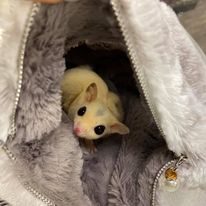1525 N. Gilbert Rd. Suite C-101 Gilbert, AZ 85234 - (480) 696-7744 - Text Message Us |
Mo, Tu, We, Th, Fr: 8am-6pm Sat: 9am-2pm Sun: Closed |
1525 N. Gilbert Rd. Suite C-101 Gilbert, AZ 85234 - (480) 696-7744 - Text Message Us |
Mo, Tu, We, Th, Fr: 8am-6pm Sat: 9am-2pm Sun: Closed |
(480)696-7744
www.littlecrittersvet.com
Sugar Glider Comprehensive Care Guide
Natural EnvironmentOriginating from the forests and woodlands of Australia, sugar gliders are nocturnal animals, meaning they are most active during nighttime hours. LifespanWhen well-cared for, sugar gliders can live upwards of 12 years, making them a long-term commitment as pets. SexingIdentifying the sex of a sugar glider is straightforward: females have a mid-abdominal pouch, while males possess a pre-penile scrotum. HousingSugar gliders are highly social and should never be housed alone. A large, well-ventilated cage, often adapted from bird cages, is ideal. The mesh or screen should be fine enough to prevent escapes. The cage should contain a variety of elements like a sleeping pouch, a hide box, and climbing perches. Toys such as parrot toys and rodent wheels can add extra stimulation. DietSugar Glider Feeding Guide
Feeding your sugar glider a balanced and nutritious diet is crucial for their well-being. This guide aims to provide comprehensive information on how to properly feed your sugar glider, covering various diet options, treats, and supplements. Essential Diet ComponentsSugar gliders require a diet that is a mix of proteins and sugars/gums. Below are two recommended diet options:
TreatsWhile sugar gliders enjoy treats, it's important to offer them in moderation. Suitable treats include small portions of fresh fruits, vegetables, baby food, and dairy products. SupplementsSupplementing your sugar glider's diet with vitamins and minerals is often necessary. A product like Rep-Cal Herptivite can be sprinkled over food. Ensure that any calcium supplement used is phosphorus-free. WaterHydration is crucial for sugar gliders. Always provide clean, fresh water. A water bottle is usually the most effective and hygienic way to offer water. Consult a VeterinarianIt's essential to consult a veterinarian experienced in exotic pet care to tailor the diet to your sugar glider's specific needs, especially if you notice any signs of illness or nutritional deficiencies. WaterAlways provide clean, fresh water. A water bottle is usually the most effective and hygienic way to offer water. Medical ConcernsSugar gliders are prone to a variety of health issues including hind limb paralysis syndrome, nutritional disorders, obesity, cataracts, trauma, respiratory disease, parasites, gastrointestinal issues, stress-related diseases, pouch disorders, and dental disease. Regular veterinary check-ups are crucial for early diagnosis and treatment. Sugar Glider Common Medical Problems GuideOwning a sugar glider comes with the responsibility of recognizing and addressing various health issues that these exotic pets may face. This guide aims to educate sugar glider owners on common medical problems and their symptoms. Hind Limb Paralysis SyndromeThis condition is often related to calcium or nutritional imbalances. Symptoms include weakness or paralysis in the hind limbs. Immediate veterinary care is essential for diagnosis and treatment. Nutritional DisordersImproper diet can lead to a range of nutritional disorders, including metabolic bone disease. Symptoms may include lethargy, weakness, and deformities. Consult a veterinarian for a proper diet plan. ObesitySugar gliders are prone to obesity if fed an improper diet rich in sugars and fats. Obesity can lead to other health issues like heart disease and diabetes. Regular exercise and a balanced diet are crucial. CataractsThis eye condition can affect sugar gliders, especially as they age. Symptoms include cloudiness in the eyes. Veterinary care is essential for diagnosis and potential surgical intervention. TraumaSugar gliders are active and curious, making them susceptible to falls and injuries. Any signs of trauma, such as limping or difficulty moving, should be addressed immediately by a veterinarian. Respiratory DiseaseSymptoms include wheezing, difficulty breathing, and nasal discharge. Respiratory issues can be serious and require prompt veterinary attention. ParasitesInternal and external parasites can affect sugar gliders. Symptoms may include scratching, skin irritation, and digestive issues. Regular fecal exams can help in early detection and treatment. Gastrointestinal DiseaseSymptoms like diarrhea, vomiting, or loss of appetite can indicate gastrointestinal issues. These symptoms require immediate veterinary consultation for diagnosis and treatment. Stress-related DiseaseStress can manifest in various ways, including self-mutilation and changes in eating habits. Identifying and eliminating the stressor is crucial, along with veterinary consultation. Pouch Disorders in FemalesFemales may experience issues like infection or inflammation in their pouch. Symptoms include redness, swelling, and discharge. Immediate veterinary care is required. Dental DiseaseSigns of dental disease include difficulty eating, drooling, and bad breath. Dental issues can lead to other health problems and should be addressed promptly. Consult a VeterinarianRegular veterinary check-ups are essential for early diagnosis and treatment of these common medical issues. Always consult a veterinarian experienced in exotic pet care for accurate diagnosis and appropriate treatment. |